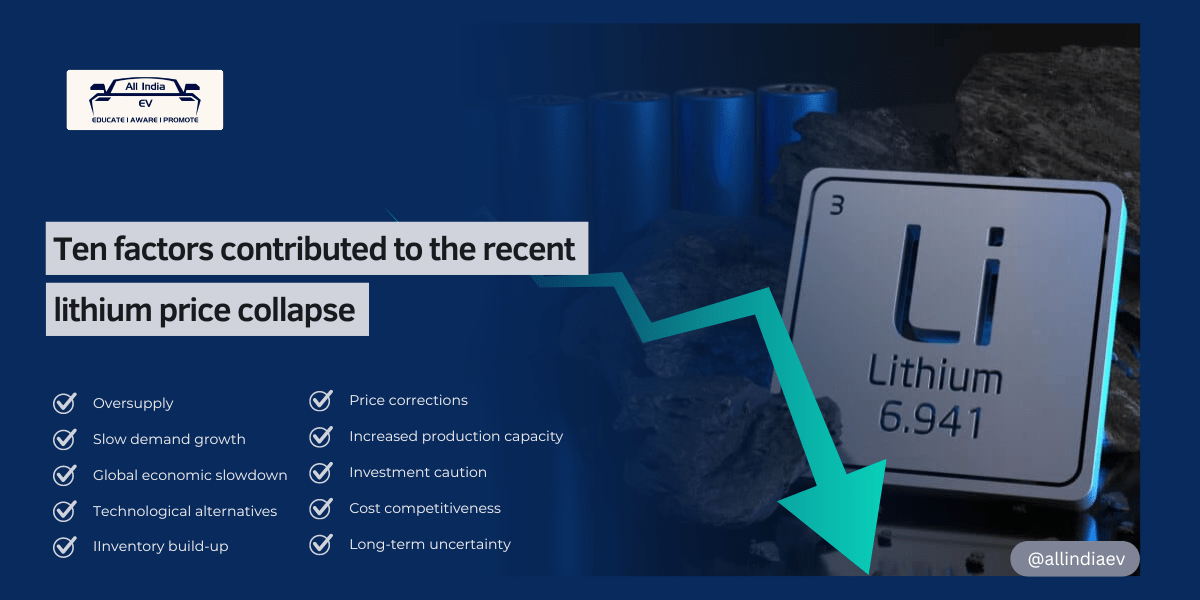
10 Reasons for the Lithium Price Collapse: Full analysis
Just two years ago, lithium carbonate was on fire, reaching as much as $82,000 per tonne. This year has been quite a different story, though. An eye-watering fall of 84% means it is now a lowly $13,000 per tonne. Briefly in April, prices rebounded to $16,000 but slumped again by June to $12,000, according to Forbes. If this continues, according to August 23rd data provided by Investing.com, the situation looks even worse: Lithium Carbonate 99.5% Min China Spot prices sank to 74,000 CNY, or about $10,400. What has caused this freefall in the price of lithium? Following are ten fundamental reasons:
Lithium Demand: Slow Growth
Despite the rapid growth of the electric vehicle market, the demand for lithium cannot satisfy optimism. According to figures from the International Energy Agency, in 2023, some 14 million new EVs will have been registered. Yet around the world, some 60% of the bulk of growth was concentrated in China; Europe’s share of growth amounted to 25%, while the U.S.’s equated to 10%. For instance, just last week, Ford decided to cancel plans for the large electric SUV because market demand for EVs has proved weaker than the auto manufacturer anticipated—a development that underlines the daunting odds facing lithium producers.
Lithium Glut: Oversupply
Despite all the hype, lithium demand hasn’t yet kept pace with the lofty rhetoric surrounding EVs. According to International Energy Agency data for 2023, while some 14 million new EVs were registered globally, some 60% of this growth took place in China, Europe accounted for 25%, and the U.S. for 10%. It was only a week ago that Ford axed plans for a large electric SUV, amid an underwhelming market appetite for the EV segment-a stark reminder of the challenges Lithium producers are facing.
Production Surge Outpaces Demand
Supply disappointment has hit the lithium market big time. Output has surged, notably in powerhouse producers such as Australia and Chile, spearheaded by China. In fact, this surge has brought supply way higher than demand. For example, Chile’s copper commission, Cochilco, recently said that the country’s lithium output could be as high as 285,000 tonnes next year, Mining.com reported. All of this major production growth-combined with other trends elsewhere of similar magnitude-is bad news for lithium prices.
Economic Headwinds Dampen Lithium Demand
To a large extent, there have been economic drags in the Chinese lithium market. Problems inside the economy have seen the curtailing of purchases in electronic vehicles. A few months back, the chief executive officer at General Motors did recognize this trend by mentioning that growth in electric vehicles had cooled, and indeed the company was going to change its production plans in order to suit the prevailing low demand. That shows there is a force of broader economic factors contributing substantially to the determination of the lithium market.
Excess Inventory
Yet, this very lithium battery possesses some serious environmental concerns. Lithium battery recycling is an extremely complex and energy-intensive process. In addition, the fabrication process requires a great amount of water. These disadvantages became the driving forces toward greener alternatives. Here come the sodium-ion batteries. However, sodium is far more common compared to lithium, according to the American Chemical Society, which states the abundance to be 23,600 ppm to 20 ppm, respectively, in Earth’s crust. All these facts combined with a great potential for further tuning to a more optimized production and recycling process make the sodium-ion battery quite appealing.
Expanding Production Capacity
A race is on to secure supplies of lithium. Companies are expanding mines and exploring new reserves in countries around the world. In itself, that increase in production capacity adds to oversupply, pulling down the price of lithium today. As recently as last month, German Chancellor Olaf Scholz discussed a possible lithium excavation deal with Serbia. Closer to home, India inked an agreement with Argentina early this year to explore lithium opportunities. The increasing momentum in Li production is reflected in S&P Global’s December report, which forecasts that Europe’s total annual lithium processing capacity could reach as high as 650,000 mt/year by 2028 based on current plans.
Increase in Lithium’s Price
The disparity in lithium supply and demand has prompted producers to rethink their strategies. With prices decreasing, companies are making large changes. A notable example is Pilbara Minerals of Australia, which recently said it will cut back on spending related to long-term expansion projects because of a dramatic decline in full-year net income resulting from lower lithium prices (according to Bloomberg). This is indicative of the need for the industry to revamp itself in the changing market.
Investor Caution Amid Global Challenges
The global economy faced significant storms in recent years. The COVID-19 pandemic, the Russia-Ukraine war, the Israel-Gaza conflict, and rising tensions in the Middle East have all added to an already volatile environment. Interest rates have increased as central banks raised rates in response to inflationary pressures, underscoring the uncertainty in investing. Additionally, the uncertainty surrounding the U.S. elections and other ongoing geopolitical tensions has contributed to a less favorable demand environment and also a challenging backdrop for lithium-related investments.
Pressure Mounts on Producers
A combination of supply exceeding demand and weak demand have led lithium prices to decline sharply. The resulting pressure on prices may drive producers to reevaluate their production. As costs escalate and revenue declines, some companies may be forced to downsize their production, or even to cease operations completely. The competitive environment for lithium continues to become more difficult, and some lithium producers may not survive if the current environment does not change.
Lithium’s Future: A Question of Technology
Although lithium has established itself as a primary factor in the energy storage evolution, the long-term sustainability of lithium as its primary energy storage technology in continued flux. Alternative battery technologies, such as sodium-ion batteries and solid-state batteries, appear to provide opportunities for even cheaper and more sustainable energy storage battery systems than lithium. As new battery technologies evolve, they could potentially introduce new levels of competition and uncertainty in the lithium market.









